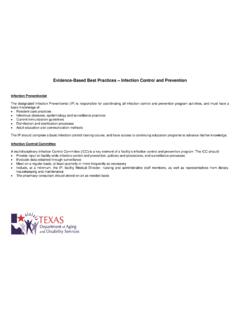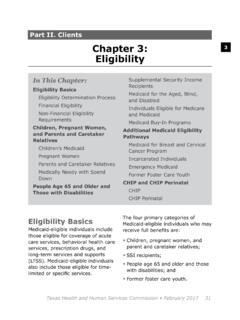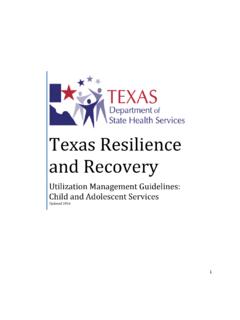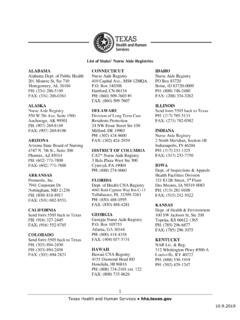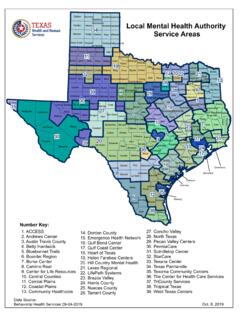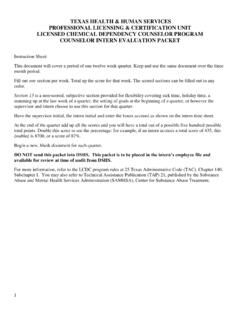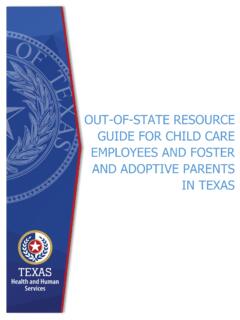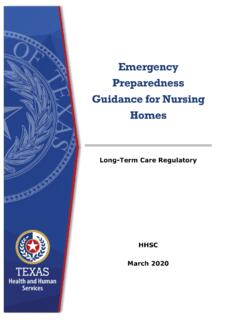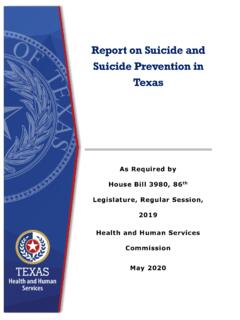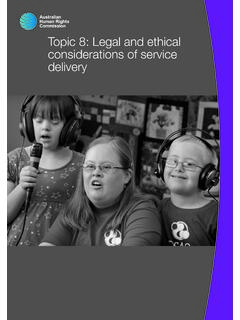Transcription of Abuse, Neglect, and Exploitation (ANE) Module
1 1 | Page abuse , neglect , and Exploitation May 2017 abuse , neglect , and Exploitation (ANE) Module 2 | Page abuse , neglect , and Exploitation May 2017 Table of Contents About this Module / 3 4-5 Chapter 6-8 Overview Definitions Categories of abuse State Reporting and Investigation Requirements/Safe Harbor and ANE Chapter 9-11 Signs and Symptoms Risk Factors Factors in Nursing Homes Assessment/Screening/Identification of ANE Chapter 12-13 Personal-Accountability Prevention of ANE Chapter 14-16 Federal Regulation Chapter 17-21 Resources Videos Examples Case Scenario Activities Scavenger Hunt ANE In-service
2 Presentation CMS Hand-in-Hand Modules 2 & 5 22-23 3 | Page abuse , neglect , and Exploitation May 2017 About this Module : Nurses must be able to recognize the clinical indicators of elder abuse , neglect , and Exploitation (ANE) and need to know what actions to take if ANE is suspected. However, many nurses are not aware that ANE even exists, and few are adequately trained to screen and assess for ANE. Understanding cultural competency is essential to any ANE training. Different cultures perceive aging and care-giving differently and this has important implications for the way ANE is viewed, assessed and treated. Elder ANE are universal problems, and are highly prevalent in institutional type settings such as nursing homes. Raising awareness and prevention of elder ANE requires the involvement of the nurse providing care to these individuals. To assist in raising awareness, the ANE Module of this toolkit was developed. Overview: Every year, an estimated 4 million older Americans are victims of physical, psychological or other forms of abuse and neglect .
3 Those statistics may not tell the whole story. For every case of elder abuse and neglect reported to authorities, experts estimate as many as 23 million cases go undetected. The quality of life of older individuals who experience abuse is severely jeopardized; they often experience worsened functional and financial status, as well as progressive dependency, poor self-rated health, feelings of helplessness and loneliness and increased psychological distress. Research also suggests that older people who have been abused tend to die earlier than those who have not been abused, even in the absence of chronic conditions or life-threatening disease. Like other forms of abuse , elder abuse is a complex problem, and it is easy for people to have misconceptions about it. Effective interventions can prevent or stop elder abuse . Improving the ANE training of nurses who provide care to older adults in nursing facilities can help break patterns of abuse or neglect , and both the person experiencing the abuse and the abuser can receive needed help.
4 Objectives: The objectives for this Module are: a. Identify the signs and symptoms of ANE b. Describe factors contributing to institutional ANE of elders c. Discuss the available resources for reporting elder ANE and obtaining assistance d. Describe the nurse s role in identification and prevention of elder ANE e. Discuss Federal and State Regulations 4 | Page abuse , neglect , and Exploitation May 2017 Pretest: 1. Physical abuse is the most common form of abuse that is inflicted on elder individuals. True False 2. Sexual abuse is only diagnosed when the resident describes rape. True False 3. neglect is a lesser form of mistreatment against elders. True False 4. Elder mistreatment is a public health problem. True False 5. The number of new cases of elder mistreatment reported in the United States each year is almost 500,000 and represent a major public health problem.
5 True False 6. Bruises over the chest and face are indicators of physical abuse . True False 7. Malnutrition is always an indicator of neglect . True False 8. Hip fractures are not indicators of elder abuse in residents older than 75 years because these residents usually have osteoporosis and a history of frequent falls. True False 9. A red-purple bruise is more severe and older that a yellow-green one. True False 10. Skin lacerations are cuts with raised, inflamed edges. True False 11. Decubiti are normal lesions of the skin in residents who cannot move without help. True False 12. Residents who are unable to perform 4 activities of daily living (ADLs) are at less risk of ANE than residents who are isolated. True False 5 | Page abuse , neglect , and Exploitation May 2017 13. Dehydration is a common presenting sign of neglect and can be complicated by confusion.
6 True False 14. Those that are isolated are more vulnerable to an instance of ANE. True False 15. Burns are common injuries in elders who live in nursing homes. True False 16. Elders are never victims of sexual abuse . True False 17. Only social workers are responsible for the assessment of elder mistreatment. True False 18. Excessive or insufficient medication of an older patient is an indicator of ANE. True False 19. An incidence of ANE that is reported by a resident with dementia should be investigated by the care provider. True False 20. Alcoholism is a risk factor of ANE only if the care provider is a heavy drinker. True False Answers: 1. F 2. F 3. F 4. T 5. T 6. T 7. F 8. F 9. F 10. T 11. F 12. F 13. T 14. T 15. F 16. F 17. F 18. T 19. T 20. T 6 | Page abuse , neglect , and Exploitation May 2017 Chapter 1: Overview: abuse , neglect and Exploitation are some of the worst experiences an older adult might go through in their life.
7 It is estimated that 1 in 4 vulnerable elders are at risk for abuse1, with estimated occurrences of abuse in 1 out of every 3 nursing homes2. Since April of 2012, the instances of verified ANE complaints in Texas NFs have been increasing, from 645 cases between April 1, 2012 and March 31, 2013 to 1023 cases from April 1, 2014 through March 31, 2015. According to the National Center on Elder abuse , the number of older adults who are mistreated each year is close to 5 million and is rising3. The instance of ANE to a NF resident can impact his or her physical, mental, and emotional well-being, and can lead to death. As adults grow older they may become more physically frail, may not see or hear as well as they used to, and may develop cognitive problems such as dementia. As a result, they become increasingly vulnerable to abuse and neglect . Elder abuse laws have been enacted in each individual state, and the Centers for Medicare & Medicaid Services has issued regulations for nursing facilities as well.
8 As caregivers it is your responsibility to know both your state and federal regulations. We know the mistreatment of older adults takes many forms, including physical, verbal, emotional and sexual abuse , financial Exploitation , and neglect . This is the case even though incidents of abuse often go unreported. Why aren t they reported? Victims of elder abuse and neglect may feel ashamed of their abusive experiences. Those who consider reporting abuse often choose not to because, in the majority of cases, they are abused by a family member, loved one, or trusted caregiver. Definitions: a. abuse : The willful infliction of injury, unreasonable confinement, intimidation, or punishment with resulting physical harm, pain or mental anguish (42 CFR )4. abuse can be mental, physical, sexual, or verbal. According to Federal Regulations Tag 223, the resident has the right to be free from verbal, sexual, physical, and mental abuse , corporal punishment, and involuntary seclusion caretaker, family member, or other individual who has an ongoing relationship with the person5.
9 B. neglect : The refusal or failure to provide good or services, including medical services that are necessary to avoid physical or emotional harm, pain, or mental illness4. neglect typically 1 Oxford Journals. The prevalence of elder abuse and neglect : a systematic review. 2 ABC News. Elderly Abused at 1 in 3 Nursing Homes: Report. 3 Resources: Preventing Elder abuse and neglect in Older Adults. :preventing-elder- abuse -and- neglect -in-o lder-adults/ 4 Code of Federal Regulations (2016). Retrieved from 5 Texas Administrative Code, Title 40, Part 1, Chapter 19, Subchapter B, Rule Definitions. $ 7 | Page abuse , neglect , and Exploitation May 2017 means the refusal or failure of those responsible to provide an elderly person with such life necessities as food, water, clothing, shelter, personal hygiene, medicine, comfort, personal safety, and other essentials. c. Exploitation : the illegal or improper use of an elder's funds, property, or assets.
10 Examples include, but are not limited to, cashing an elderly person's checks without authorization or permission; forging an older person's signature; misusing or stealing an older person's money or possessions; coercing or deceiving an older person into signing any document ( , contracts or will); and the improper use of conservatorship, guardianship, or power of attorney6. Categories of abuse : a. Physical abuse : The use of physical force that may result in bodily injury, physical pain, or impairment. Physical abuse may include but is not limited to such acts of violence as striking (with or without an object), hitting, beating, pushing, shoving, shaking, slapping, kicking, pinching, and burning. In addition, inappropriate use of drugs and physical restraints, force feeding, and physical punishment of any kind are examples of physical abuse5. b. Emotional or Psychological abuse : The infliction of anguish, pain, or distress through verbal or nonverbal acts.
